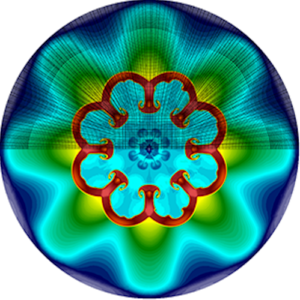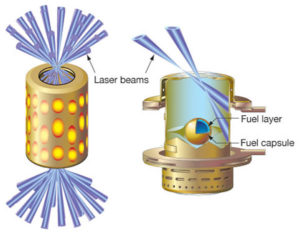 During the summer of 2017 I interned with the Design Physics Division at LLNL. This was the first time I got to see supercomputing in action, and I learned about many exciting applications for modeling and analysis. In particular, the group I was working with was modeling Inertial Confinement Fusion (ICF) implosions, which make use of the NIF laser I mentioned earlier. ICF experiments involve shooting an enormously high-powered laser at a small fuel source to induce nuclear fusion. Studying nuclear fusion has applications in weapons design, astrophysics research, and sustainable energy. As of today, ICF experiments have not been able to generate a net positive energy output. The main challenge involves controlling the fluid mixing instabilities that occur when an asymmetrical driving force is applied to the exterior of a fuel capsule (pictured on the left). Finding a solution to this phenomena involves extremely accurate modeling. My project was to design test simulations and diagnostics for the introduction of a Non-local Thermal Equilibrium (NLTE) physics package into an ICF simulation code called Kull, which would improve how it treated extreme temperature physics.
During the summer of 2017 I interned with the Design Physics Division at LLNL. This was the first time I got to see supercomputing in action, and I learned about many exciting applications for modeling and analysis. In particular, the group I was working with was modeling Inertial Confinement Fusion (ICF) implosions, which make use of the NIF laser I mentioned earlier. ICF experiments involve shooting an enormously high-powered laser at a small fuel source to induce nuclear fusion. Studying nuclear fusion has applications in weapons design, astrophysics research, and sustainable energy. As of today, ICF experiments have not been able to generate a net positive energy output. The main challenge involves controlling the fluid mixing instabilities that occur when an asymmetrical driving force is applied to the exterior of a fuel capsule (pictured on the left). Finding a solution to this phenomena involves extremely accurate modeling. My project was to design test simulations and diagnostics for the introduction of a Non-local Thermal Equilibrium (NLTE) physics package into an ICF simulation code called Kull, which would improve how it treated extreme temperature physics.—————————————
 More specifically, NLTE occurs when a material is absorbing more energy than it can radiate away (i.e. when it is getting hit by a laser). Modern ICF experiments are set up so that the target (a tiny mm scale capsule containing a deuterium/tritium mixture of fuel), is surrounded by a cylinder called the “hohlraum.” Depicted on the right, the incoming laser beams impact the hohlraum wall, releasing a shower of x-rays that bombard the target capsule in a more symmetrical pattern that reduces the fluid mixing instabilities I mentioned earlier. Factoring in NLTE physics changes the radiation spectrum of the hohlraum material, and I was able to capture that on my test simulations with some animated diagnostics I coded in python. Feel free to check out my poster in the media page, where you can also download a presentation I made that contains videos of the simulations and the corresponding animated diagnostics.
More specifically, NLTE occurs when a material is absorbing more energy than it can radiate away (i.e. when it is getting hit by a laser). Modern ICF experiments are set up so that the target (a tiny mm scale capsule containing a deuterium/tritium mixture of fuel), is surrounded by a cylinder called the “hohlraum.” Depicted on the right, the incoming laser beams impact the hohlraum wall, releasing a shower of x-rays that bombard the target capsule in a more symmetrical pattern that reduces the fluid mixing instabilities I mentioned earlier. Factoring in NLTE physics changes the radiation spectrum of the hohlraum material, and I was able to capture that on my test simulations with some animated diagnostics I coded in python. Feel free to check out my poster in the media page, where you can also download a presentation I made that contains videos of the simulations and the corresponding animated diagnostics.